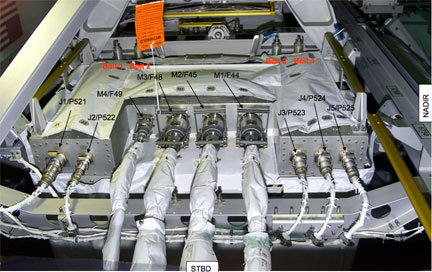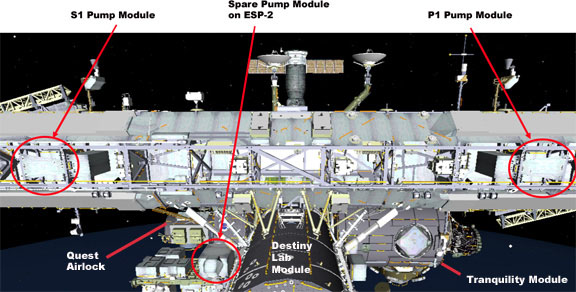NASA refines spacewalk plans for cooling pump changeout (UPDATED)
08/02/2010 01:20 PM Filed in: International Space Station | Space News
Editor's note...
NASA astronauts and engineers are refining plans for two spacewalks by astronauts Douglas Wheelock and Tracy Caldwell Dyson to replace a large ammonia pump module that shut down Saturday, knocking out one of the International Space Station's two cooling loops.
The astronauts hope to carry out the first spacewalk Friday morning and a second excursion Monday to finish the job, one of the so-called "big 14" on a list of critical components that require spacewalk repair if problems crop up.
NASA managers initially targeted Thursday for the first spacewalk and Sunday for the second, but decided late Monday they needed more time to review procedures.
 An ammonia pump module, showing electrical and fluid line
An ammonia pump module, showing electrical and fluid line
connections.
(Photo: NASA TV)
- Updated at 6:25 PM with NASA news briefing; quotes and details
- Updated at 7:45 PM with decision to re-target spacewalks for Friday/Monday
- Updated at 9:25 PM to CORRECT truss segments housing pump modules (S1/P1)
NASA astronauts and engineers are refining plans for two spacewalks by astronauts Douglas Wheelock and Tracy Caldwell Dyson to replace a large ammonia pump module that shut down Saturday, knocking out one of the International Space Station's two cooling loops.
The astronauts hope to carry out the first spacewalk Friday morning and a second excursion Monday to finish the job, one of the so-called "big 14" on a list of critical components that require spacewalk repair if problems crop up.
NASA managers initially targeted Thursday for the first spacewalk and Sunday for the second, but decided late Monday they needed more time to review procedures.
 An ammonia pump module, showing electrical and fluid line
An ammonia pump module, showing electrical and fluid lineconnections.
(Photo: NASA TV)
"This is an anomaly we knew someday would happen," said space station Program Manager Mike Suffredini. "It's an anomaly we have trained for, it's an anomaly we have planned for."
With four spare pump modules on board the station, "we're in a good position to go solve this problem," he said. "It is a significant failure, though, in terms of systems on board ISS, so it's one we need to go after."
The shutdown of coolant loop A forced the station crew, working with flight controllers at the Johnson Space Center, to quickly power down a variety of critical systems to prevent overheating, including a communications channel, two of four stabilizing gyroscopes, a GPS navigation sensor and several computer control boxes and heaters.
Engineers attempted to restart the pump early Sunday and "the data suggests the motor and impeller are not frozen," Suffredini said. "In fact, the motor did start to pump some of the ammonia when we tried to start it the second time."
But in a repeat of the Saturday malfunction, a circuit breaker tripped within a few moments "so this tells us there's a short somewhere in the power feed to the motor between the controller and the motor."
The pump module was installed and electrically activated in 2002. The pump was not turned on for active cooling until late 2006. Based on ground testing, the "mean time between failures" was calculated to be around 100,000 hours. The pump in question failed earlier than that, after about 80,000 hours of combined electrical and mechanical operation.
Suffredini said engineers hope to get the faulty unit back for a detailed failure analysis, but there is no room on the next two shuttle flights, the final two missions on NASA's manifest. There is congressional support for an additional flight next June, however, and if that mission is approved, Suffredini said room would be available to bring the old pump home.
In any case, flight controllers analyzed heat loads after Sunday's restart attempt and were able to revive one of the shut-down gyros. Other components were switched to coolant loop B and officials said the six-member crew - three American astronauts and three Russian cosmonauts - was never in any danger.
But the coolant loops, which circulate ammonia through huge radiators to dissipate the heat generated by the station's electronics, are critical to lab operations. With one loop out of action, the station is one failure away from a major shutdown that would be much more difficult to resolve.
As a result, NASA managers decided Sunday to defer more routine tasks in an already planned spacewalk Thursday and to proceed instead with a pump module changeout, a job that will require two spacewalks to complete.
The loop A pump module is mounted on the forward face of the station's main power truss, just above and to the right of the Destiny laboratory module, in the starboard 1, or S1, truss segment. Its loop B counterpart is mounted to the left of Destiny in the port 1 truss segment.

(Credit: NASA)
The Boeing-built 780-pound pump modules measure 5-and-a-half feet long, 4 feet wide and 3 feet high. It is too large to fit aboard European or Russian unmanned cargo craft.
With only two, or possibly three, flights left on NASA's shuttle manifest, the agency been launching as much in the way of spare parts and components as possible on recent flights as a hedge against failures after the shuttle stops flying.
Four spare ammonia pump modules already are stored aboard the space station. One is mounted on External Storage Platform No. 2 by the Quest airlock on the right-side of the station, about 30 feet or so from the failed unit in the S1 truss segment. That is the pump that will replace the one that malfunctioned.
A second pump module is mounted on ESP No. 3, attached to the upper side of the port three power truss segment on the left side of the station. A third is attached to a logistics carrier on the lower side of the P3 truss segment and the fourth is attached to a carrier on the upper side of the starboard 3 truss.
Wheelock and Caldwell Dyson were preparing to carry out a spacewalk Thursday to mount a robot arm mounting fixture on the Russian Zarya module and to prepare NASA's central Unity module for attachment of a storage compartment during a shuttle flight in November.
They practiced an ammonia pump swap out during a September 2009 training run. Astronauts at the Johnson Space Center are now practicing the swap out in the huge swimming pool NASA uses to simulate weightlessness to refine those procedures and develop a reliable timeline.
That information will be radioed to Caldwell Dyson and Wheelock for review on the space station over the next two days.
"They're in great spirits, they're ready to do this EVA," Suffredini said. "This is one of the 'big 14' EVAs, which to date we haven't had to do yet. The big 14 refers to some of the major (components) an increment crew might have to do without the shuttle vehicle there.
"We don't train them all," he said. "The crews train generically for maintenance and then train for some of the big 14. This particular one, the crew did train for, so they have some familiarity with the task being asked of them."
Overall, he said, "we're actually in great shape. To have the EVA already planned (for this Thursday), that is significant because there's quite a bit of work to configure the airlock, get everything set up for the crew to use the suits."
Most of that work had already been done in preparation for the previously planned spacewalk and "that was really a blessing in terms of the time to get to this job." Even so, spacewalk planners needed more time to refine procedures for the pump replacement EVA, pushing the first excursion to no earlier than Friday.
The current plan calls for the astronauts to first remove the failed pump module and temporarily mount it on an external storage fixture. A "jumper box" will be attached to two of the ammonia lines, preventing possible pressure problems as coolant in the lines expands.
The pump module "is a difficult box to maneuver with, it's a big, unwieldy object," said space station Flight Director Courtenay McMillan. "So maneuvering it around and handing it off between crew members if that needs to be done, that could take some time. None of that part of it is technically difficult, but it's just very time consuming and takes a lot of focus."
The new pump then can be removed from ESP-2 and bolted into place on the S1 truss segment. During a second spacewalk, Wheelock and Caldwell Dyson will make the required electrical connections, disconnect the jumper box and attach the ammonia lines.
Engineers are still thrashing out the details. With a single working coolant loop, the electronics used to run and operate station's robot arm cannot be allowed to overheat. Its not yet clear whether the arm can be used to move a spacewalker, the spare pump module, both or neither.
Another complication is managing the station's solar arrays. The station and its huge arrays can generate a charge as the lab moves through the tenuous upper atmosphere at 5 miles per second and two devices, called plasma contactor units, operate during spacewalks to minimize the shock hazard to the spacewalkers.
With the failure of coolant loop A, one of those devices is out of action. Under current flight rules, that would require all but two of the station's solar arrays to be parked and locked in a favorable orientation, unable to track the sun, during the spacewalk. If that rule remains in play, the astronauts could be faced with additional powerdowns during the spacewalk.
Finally, planners will have to make sure Wheelock and Caldwell Dyson have enough air and power for possible ammonia contamination "bake out" procedures at the end of the spacewalk. Engineers plan to vent the ammonia lines leading to the pump module on Tuesday, but even residual ammonia poses a risk if it is brought back into the station on a contaminated spacesuit.
As a result, the astronauts must have enough time available at the end of their planned work to let any trace amounts of ammonia bake out, or sublimate, before re-entering the space station.
"Since the external loop uses ammonia as the cooling fluid, all the lines are pressurized with ammonia and have to be released by the crew during the EVA," McMillan said. "We've done this before with different parts of the thermal system. The crew is very well trained on how to do decontamination if they get ammonia on them during the procedures. But it presents a timeline challenge to make sure we have enough room in the timeline to account for that."